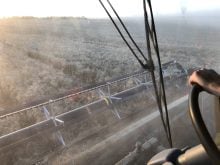This year western Canadian farmers harvested a high-quality Canada Western Red Spring (CWRS) wheat crop — albeit a smaller one due to drought.
Ninety per cent of the 3,500 or so samples submitted to the Canadian Grain Commission (CGC) through its annual Harvest Sample Program fell into the top two grades. Almost 96 per cent are in the top three.
“Even though there were challenges with production — it looks like production is down roughly a third from normal — we have 66 per cent of CWRS samples grading No. 1 and approximately 24 per cent of samples grading No. 2,” CGC chief grain inspector Derek Bunkowsky said in an interview Nov. 30. “So we’re sitting with 90 per cent in the top two grades and that’s excellent.”
Why it matters: Top-quality CWRS wheat and strong prices will help farmers make up some of the losses from this summer’s drought.
Western farmers reaped several high-quality wheat crops in a row, but most years there’s a bit more downgrading than there was in 2021, Bunkowsky said.

“And that has to do with the fact that for the most part we had a very open harvest with good weather,” he said. “There was one rain event that was pretty widespread across the Prairies in the middle of harvest, but fortunately I would say the majority of the wheat was off by that time.”
As a result of that rain about 13 per cent of CWRS samples were downgraded due to mildew, Bunkowsky said.
It also led to about 4.5 per cent of samples being downgraded on account of ‘severe sprout,’ he said.
“Luckily it wasn’t widespread. Even though that happened we still have over 90 per cent of CWRS samples having a falling number of 300 or higher, which is kind of the number end-use millers are looking for. It’s right in line with 90 per cent of samples meeting the top two grades.”
A high falling number is desired by bread makers as it’s a sign of good dough elasticity, which results in superior loaves.
CWRS wheat across the West is also high in protein, averaging 14.7 per cent.
“That’s significantly higher than normal,” Bunkowsky said. “Last year it was 13.3. The 10-year average is 13.6, so we’re slightly more than a percentage point higher in protein this year. That’s significant. And that allows end-users and millers additional blending capacity when they have that high protein. That’s a positive thing.”

Asked if CWRS wheat is even in higher demand now because of that extra protein, Bunkowsky replied: “I don’t know if I would say that. CWRS is always in demand because of its quality. But I will say after being on some of these calls (with buyers) we do have customers like the Japanese — I’ve probably had a half-dozen calls with them in the last week — and, yes, they’re happy that the quality is good, but they’re concerned about supply.”
Higher wheat protein and lower yields often follow a drought as more nitrogen goes into kernels than producing more seed heads.
The mean protein content for CWRS grades by province is as follows: Manitoba, 14.7 per cent, Saskatchewan, 14.6 per cent, Alberta and British Columbia (Peace River region) 14.8 per cent.
Read Also

What is perfect Christmas weather?
What is ‘perfect’ Christmas weather on the Prairies? Here’s where you should head this holiday, according to historical weather data.
The mean protein content of all CWRS wheat grades from the eastern region of Western Canada (Manitoba and the eastern half of Saskatchewan) is 15.3 per cent compared to 13.7 last year, CGC data shows.
Drought often reduces test weight but not this year.
“The CWRS test weight is still very good and in line with other years,” Bunkowsky said. “We did see more downgrading in Canada Western Amber durum on account of test weight. I think that’s because the durum region in the far-southwest corner of Saskatchewan experienced even worse drought conditions than most of the other areas of the Prairies — hotter temperatures and less rain.”
















